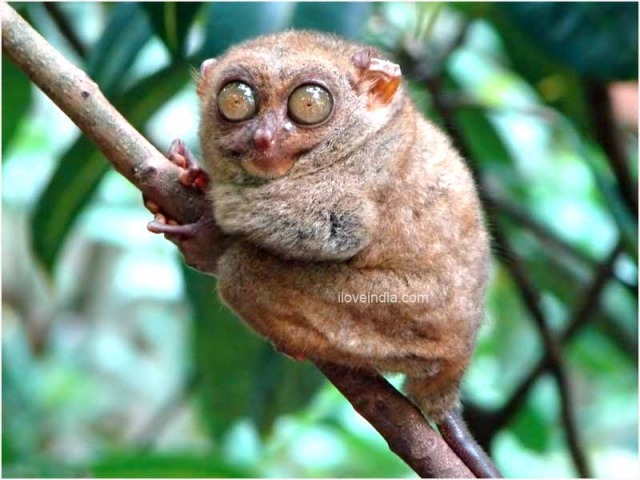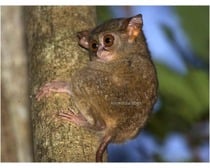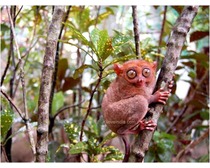Though tarsiers bear resemblance with monkeys, they belong to a different species and family. Read on to know interesting facts & amazing information on a tarsier.
Facts About Tarsier
Tarsiers are haplorrhine primates belonging to the genus Tarsius, in the Tarsiidae family, which is the only extant family within the infraorder Tarsiformes. The group used to be widespread some time back, though all the species existing now are more or less confined to the islands of Southeast Asia. While fossils of tarsiers and tarsiiform are found in Asia, Europe and North America, the extant tarsiers are limited to several of the Southeast Asian Islands, such as Philippines, Sulawesi, Borneo and Sumatra. Their fossil records lead to the conclusion that their dentition has not changed considerably over the past 45 years. Due to their resemblance with monkeys, tarsiers have often been mistaken as belonging to the same family and have been referred to as the “smallest monkeys of the world’’. Tarsiers are one of the most amazing creatures on this planet and are vulnerable to extinction due to habitat loss. Read on to know some interesting facts and amazing information on tarsiers.

Facts About Tarsier
Kingdom: Animalia
Phylum: Chordata
Class: Mammalia
Order: Primates
Suborder: Aplorrhini
Family: Tarsiidae
Genera: Tarsius
Species: Lemur Tarsier
Height: 10-15cm
Weight: 120-170gm
Life Span: 8-12 years
Diet: Insects, small reptiles & birds
Habitat: Tropical lowland & coastal forests
Age of Sexual Maturity: Two years
Gestation Period: Six months
Number of Offspring: One
Interesting & Amazing Information On Tarsiers
- Tarsiers are small-sized animals with eyes as large as their brain size. Each of its eyes measures around 16 mm in diameter. Their limbs are also very long and the feet have very elongated bones.
- The animal has a very soft and velvety fur coat on its body. The fur is generally brown or beige in color. The elongated fingers are dark brown in color and bear a twig-like appearance.
- Tarsiers are known to be nocturnal animals, though they are also seen to be active during the day. While these animals primarily feed on insects, they also prey on small animals such as rodents, reptiles and birds. Tarsiers catch the prey by pouncing on them and they are very adept at leaping from tree to tree.
- Since tarsiers comprise of endangered species, conservation efforts initially focused on forming breeding colonies for them, by keeping them in captivity. However, these animals are known to injure themselves when caged and can even die due to stress.
- An interesting fact to note about tarsier is that the animal can rotate its head nearly 360 degrees. Along with its large eyes, this trait helps the tarsiers to spot any oncoming predators with ease.
- The Philippine Island of Bohol is one Tarsier site that has seen some success in restoring the population of this species. The site has developed a large semi-wild enclosure, through which lights are used to attract the nocturnal insects for Tarsier’s diet.
- The social behavior of this animal species has been observed to depend on where they live. While at some places, they prefer to be in groups, they are seen resting and hunting alone in other habitats.
- The tarsiers residing in Siau Island are regarded to be critically endangered and were listed by Conservation International and IUCN/SCC Primate Specialist Group, among the 25 most threatened primates in 2008.
- This creature can jump to a distance that is 40 times its own body length.
- These carnivores survive on grasshoppers, birds, snakes, bats, crabs and so on.
- When a tarsier is attacked by predators, the other tarsiers together attack the predator.
- These primates are believed to have been in existence over 40 million years ago.
- Tarsiers are named so because of their strong and long ankle bones.
- Tarsiers can only hop from branch to branch, but can’t walk on the ground.
- Tarsiers have suicidal tendencies. When disturbed by loud noises and touching, they tend to bang their heads on hard surfaces until they die.
- Tarsiers lower their body temperatures while sleeping.


See also
More from iloveindia.com
- Home Remedies | Ayurveda | Vastu | Yoga | Feng Shui | Tattoos | Fitness | Garden | Nutrition | Parenting | Bikes | Cars | Baby Care | Indian Weddings | Festivals | Party ideas | Horoscope 2015 | Pets | Finance | Figures of Speech | Hotels in India : Delhi | Hyderabad | Chennai | Mumbai | Kolkata | Bangalore | Ahmedabad | Jaipur
- Contact Us Careers Disclaimer Privacy Policy Advertise With Us Lifestyle Sitemap Copyright iloveindia.com. All Rights Reserved.




